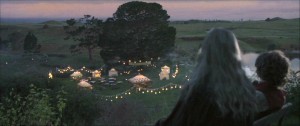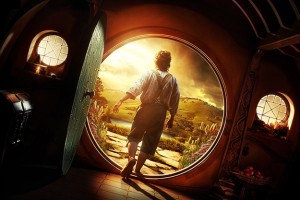 The scholar in Tolkien immediately recognized that any elaboration raised more questions than it answered; he was, however, determined to answer even those questions. So, he ventures to comment on some distal corollaries to the theme of birthdays. Thus, we learn that hobbits were, perhaps as we expected, “universally monogamous,” though that is a most unequivocal claim (Letters 293).
The scholar in Tolkien immediately recognized that any elaboration raised more questions than it answered; he was, however, determined to answer even those questions. So, he ventures to comment on some distal corollaries to the theme of birthdays. Thus, we learn that hobbits were, perhaps as we expected, “universally monogamous,” though that is a most unequivocal claim (Letters 293).
While familiar patrilineal customs were the norm, most clans and households were not patriarchal monarchies; rather, Tolkien says, they were dyarchies, “in which master and mistress had equal status, if different functions” (Letters 293). Where the eldest male would normally serve as head of a family unit, in the event of the patriarch’s death, his wife would merely assume the post he had formerly occupied, and thus, he makes clear, no title would “descend to the son, or other heir, while she lived” (Letters 294).
The example Tolkien highlights surrounds the Baggins headship. Laura Baggins had served as head of the family until her late death at 104 years old; her son, Bungo, was thus only offered 10 years at the post, as he assumed it at the ripe age of 70 and died at 80; Bilbo, as we know, was left in some doubt after the death of his mother, Belladonna. Here, many a particular legal matter arises.
Tolkien is quick to point out the confusion faced by these hobbits. For Otho (of the Sackville-Baggins line) was heir to the titular headship, though in this case, as in many, property did not transfer; thus Bilbo, much to the eternal chagrin of the Sackville-Bagginses, kept Bag End (Letters 294). However, the problem only grew in complexity; Otho died, then so, too, did Lotho and his wife, Lobelia; then Bilbo departed for the West and “it was still held impossible to presume death” (Letters 294).
This mess led then-mayor Sam Gamgee to decree a law that allowed for the conferral of property to an heir in the event of one’s passing into the West and determined intent not to return; at which point, Tolkien notes, Ponto II most likely assumed the title of “head” (Letters 294).
 Tolkien’s further description is most prodigal, and most insightful, and those looking for more specific examples of the customs and order of descent are referred to the text of the letter itself. The most interesting matter of adoption is returned to again; and an examination, certainly of the details, of the potential (if any exist) differences between the Stoors and other hobbits is resumed.
Tolkien’s further description is most prodigal, and most insightful, and those looking for more specific examples of the customs and order of descent are referred to the text of the letter itself. The most interesting matter of adoption is returned to again; and an examination, certainly of the details, of the potential (if any exist) differences between the Stoors and other hobbits is resumed.
In all, letter 214 provides a tantalizing glimpse at the artist at work, a deep, candid look into Tolkien’s scholarship and authorship; readers will find of prime interest the manner in which Tolkien addresses his role as “narrator,” rather than “creator;” he is, to his mind (and he plays the role well), but a recorder of fact, prone to error but also liable to take advantage of his license in munificent explanations. Letter 214 provides an indisputably insightful example of this dynamic; but also, for the more inclined fan, it provides much appreciated detail and insight into Middle-earth, and our most beloved Shire, especially.
Though we may not have cause as a byrding for “thanksgiving,” let us nonetheless be thankful for that.
All references to the text from: The Letters of J.R.R. Tolkien. Humphrey Carpenter, ed. with the assistance of Christopher Tolkien. London: George Allen & Unwin; Boston: Houghton Mifflin, 1981.
Tedoras is a bibliophile, linguist, and regular attendee at TORn’s live weekly webcast. He splits his time between scouring the web for Tolkien books to add to his collection and the study of Chinese politics and public policy.


